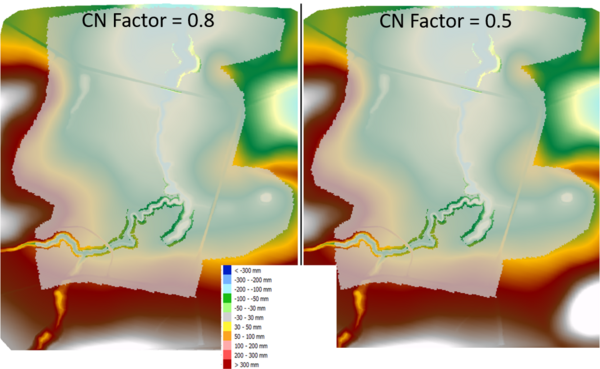HPC Impact Assessment Guidance
When completing an impact assessment, the modeller should endeavour to compare “apples with apples”. This means attempting to keep everything in the model exactly the same, apart from the development features. Because the HPC solver implements adaptive timestepping, the implementation of new features into the TUFLOW model for a development design case may result in the HPC model running with a different timeseries of timesteps to the base case model.
Though this has not been an issue to date and while it is not expected to produce any artificial impacts, there are some steps that can be taken to ensure that observed impacts are a result of the development features and not a result of change in the model timestep.
Review the HPC Timestep
The first step is to review the HPC timestep. Review of the hpc.dt.csv output for the base case and design case runs, will indicate if the minimum dt value is the same or vastly different between the two model runs. If they’re similar, it is unlikely that the dt is affecting the modelled results. Alternatively, a review of the dt raster output will show the location of the minimum timestep for each model scenario. The dt Raster output will indicate whether the minimum timestep is occurring in the location of the development or if it is in a location away from the area of interest, in which case it is very unlikely that the timestep is causing spurious impacts.
To help with keeping the model timestep between base case and design case runs the same, it’s recommended to keep the Map Output Intervals between these model runs the same as well. This is because HPC can alter the timestep of the model so that it aligns with the Map Output Intervals prescribed in the TUFLOW Control File.
Locate Impacts Outside Area of Interest
The second step is to check if there are impacts well away from the area of interest. If there are impacts in regions that should clearly not be impacted by the development (i.e. significantly upstream or on an unrelated channel), then this would require further review by the modeller and may indicate some artificial impacts as a result of the changed timestep.
Reduced Control Number Factor
If the modeller suspects the model is producing artificial impacts, the base case and design case models should be run with a reduced Control Number Factor. To reduce the likelihood of varying timesteps in the base case and design case model runs, applying a CN factor of 0.8 is recommended for all model runs in a Flood Impact Assessment. It would not be unreasonable to reduce this factor as low as 0.5 if the modelled results presented signs of artificially modelled impacts. To define the CN Factor the following command can be implemented in the TUFLOW Control File (TCF).
Control Number Factor == 0.8
If there is no difference observed in the modelled impacts, as shown below, when running the models at a CN factor of 0.8 and 0.5, then it is unlikely that the timestep is the cause of any artificial impacts.
| Up |
|---|
